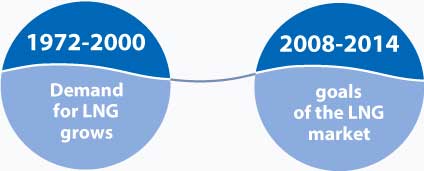LNG History

British chemist Michael Faraday was the first to experiment with the liquefaction of natural gas. In 1873, German engineer Carl von Linde built the first compression refrigeration machine.
1912: First experimental plant designed to store LNG (Virginia, USA).
1941: primo impianto commerciale di liquefazione con stoccaggio del GNL in serbatoi a pressione atmosferica (Cleveland, Ohio, USA).
1959: The first LNG experimental carrier was called Methane Pioneer and left the Louisiana Gulf headed to the UK.
1964: First commercial shipment of Algerian LNG to UK and France. The Algerian plant of Arzew was the first high capacity liquefaction terminal.
1969: Further exchanges took place between Algeria and France, Libya and Italy, and Spain and Cook Bay in Japan (this was the first project in the Pacific area).

1972-1978: The US joins the LNG market, introducing four regasification plants.
1973: First LNG import operations from Brunei to Japan; the Pacific area starts playing an important role when Korea and Taiwan join in as importing countries.
The 90's: Rise of the Atlantic area markets (Europe, North America).
2000: The market for LNG grows exponentially. Between 2000 and 2011 the annual average growth is equal to 7.5%, outdoing 300 billion of cubic meters (gaseous state).
2008: The largest LNG carrier is called the Mozah, with a capacity of 266, 000 cubic meters. Built by South Korean Samsung Heavy Industries for Qatargas and Nakilat, Mozah is the first of 14 Q-Max ships developed after the 216,000 cubic meter Q-Flex, and used to transport LNG from Qatar to Europe and from the US to the Far East.
2013: Approaching 75% of the world’s imports, Asia’s demand for LNG continues to grow.
2014: The LNG global market celebrates 50 years of history with about 80,000 transfers without significant accidents.
